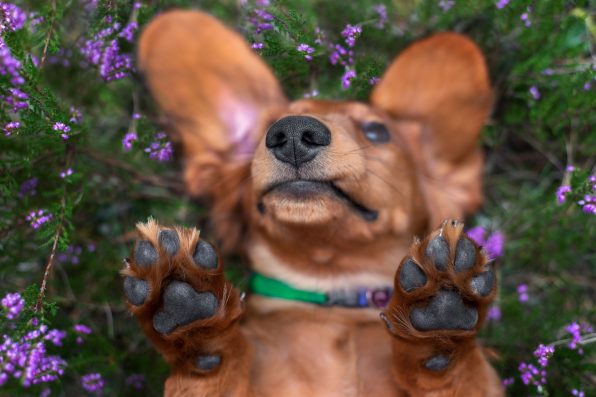Here’s How You Can Properly Care For Your Dog’s Paw Pads

Caring for your furry friend goes beyond just regular feeding, taking them to the vet, and making time to play. And one of the most overlooked aspects of their health actually lies beneath their feet.
I’m talking about your dog’s paw pads – those thick, spongy layers of skin that protect their paws.
These little cushions are tougher than human skin but can still be susceptible to various issues if not properly cared for.
From walking on hot pavements to trekking through snowy terrain, your pup’s paw pads endure a lot.
So, ensuring they remain healthy is crucial for your dog’s overall well-being and happiness.
The Importance Of Caring For Paw Pads
Paw pads aren’t just natural shoes for canines. They also serve multiple purposes – providing cushioning to protect bones and joints from shock, acting as a barrier between their feet and the ground, and helping with balance and traction.
Healthy paw pads will empower your pup to walk, run, and play without any discomfort. On the flip side, when neglected, these pads can crack, bleed, or become infected, leading to pain and mobility issues.
To make sure your dog enjoys an active and pain-free life, here are some of our top tips for paw pad care.

otsphoto – stock.adobe.com – illustrative purposes only, not the actual dog
1. Keep Paws Moisturized
Just like our human skin, your pet’s paw pads can quickly dry out. Whenever this occurs, they may crack and bleed, which is painful and uncomfortable.
You can use a dog-specific paw balm or moisturizer to keep the pads supple and prevent them from drying out, especially during harsh weather conditions.
2. Regularly Inspect & Clean Paws
Every single time you take your dog out for a walk, make it a habit to check their paws. This is especially important if they’ve been out in rough terrain or extreme weather.
Keep an eye out for any splinters, cuts, or debris stuck in their pads or between their toes. Then, gently clean their paws with a damp cloth, and be sure to remove any dirt or salt – which can be particularly irritating.
3. Trim Their Nails & Fur
Overgrown nails can actually cause canines to walk differently, resulting in uneven wear and tear on their paw pads. Similarly, fur between the paw pads can mat and lead to discomfort as well.
So, it’s best to regularly trim your dog’s nails and the fur around their paws to prevent these issues.
4. Protect Against Extreme Temperatures
Would you ever walk barefoot on a scalding-hot road during the middle of a summer day or a freezing, snow-covered trail in the dead of winter? Probably not.
Just like us, our pup’s paw pads can get burnt on hot pavement or frostbitten in icy conditions. During the warmer months, be sure to walk your dog in the early morning or late evening when the ground is cooler. You can even take your own shoes off and walk barefoot for a minute to gauge the temperature.
In the winter, you can consider using dog boots or paw wax to protect your pet’s pads from the cold and ice-melting chemicals.
5. Maintain A Healthy Weight
Finally, excessive weight can put additional pressure on paw pads, which increases the likelihood of injuries or wear and tear. That’s why keeping your dog at a healthy weight not only benefits their overall health but also reduces strain on their paws.
Common Paw Pad Problems
Cracked paw pads are a very common issue, and if you notice your dog suffering from this ailment, the best thing to do is keep their paws moisturized and avoid walks on rough surfaces until they heal.
On the other hand, if your pup’s paw pads become burned or blistered by walking on a hot surface, you may notice them limping, licking their paws excessively, or showing visible signs of distress.
You can treat burns by cleaning the affected area and applying a pet-safe ointment. Also, avoid any more walks on hot surfaces until they heal.
Cuts, punctures, and even excessive licking can lead to paw pad infections as well. Some signs of this may include swelling, redness, and a foul-smelling odor. If you think your dog might have an infection, it’s best to consult your veterinarian.
Last but not least, some dogs are actually allergic to certain grasses, chemicals, or even their own cleaning products. These allergic reactions can cause paw pads to become swollen, red, or itchy.
If you suspect an allergy, you can try to identify and eliminate the trigger. Consulting your veterinarian for appropriate treatment is also advised.
Sign up for Chip Chick’s newsletter and get stories like this delivered to your inbox.
More About:Animals





